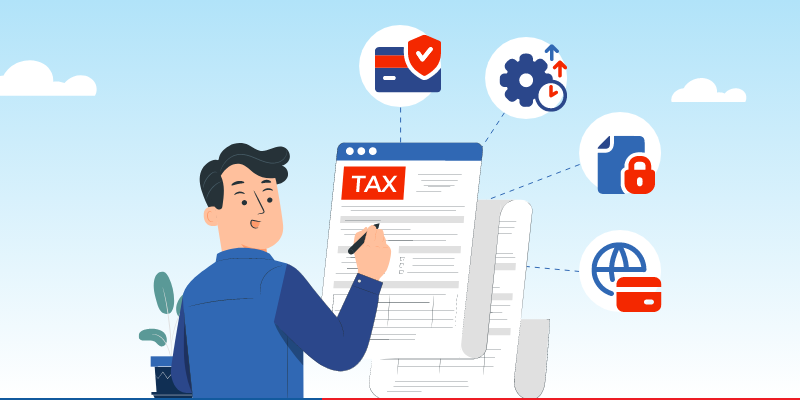Electronic tax payment (e-tax payment) has grown in popularity as a means for taxpayers to meet their tax liabilities today.
The term “e-tax payment” is used to describe the practice of filing tax returns and remitting tax payments using encrypted Tax Deposit Online systems. There are many benefits to using this system instead of the conventional paper-based procedures, including increased efficiency, convenience, and safety.

This article will go into these advantages, explaining why electronic tax payment is changing the landscape of tax administration.
The Pros of Electronic Tax Payments
The privacy and safety of taxpayers’ financial data are prioritised in the development of electronic tax payment systems. Data transmission is protected from eavesdropping and other forms of interference by means of encryption and other end-to-end protocols.
Given below are the benefits of electronic tax payments:
Convenience
The ease it brings to taxpayers’ lives is a major benefit of electronic tax payment. Prolonged waits to file returns and make tax payments at post offices and banks are a thing of the past. Electronic tax filing and payment allows filers to do their business anytime, anywhere.
Thanks to Income Tax Deposit Online portals’ compatibility with a wide range of devices, users can easily file their taxes whenever it is most convenient for them. In addition to saving time and effort, this convenient accessibility makes tax compliance a breeze.
Simplified Procedure
When taxes are paid electronically, paperwork is eliminated, and time is saved. Taxpayers are prompted to put in proper information at each step via the electronic platforms. Because the system does the math automatically, mistakes in the numbers that could result in over or underpayment of taxes are greatly reduced.
To further aid taxpayers in avoiding typical mistakes, e-tax payment offers real-time validation, notifying them of any missing or incomplete information. The time it takes to file taxes goes down, and you get your refund (if any) or assessment (if any) faster as a result.
Increased Safety
When it comes to dealing with money, safety has always been of the utmost importance. Protecting taxpayer privacy and financial data is a top priority for online tax payment systems.
Data transmissions are protected by cutting-edge encryption methods, making it difficult for prying eyes to capture and read sensitive data in transit. One-time passwords (OTPs) and biometric verification, two more secure authentication techniques, provide an additional safeguard against identity theft and fraud.
Less Paper Used, Less of an Effect on the Environment
Using less paper during tax administration is a major benefit of embracing electronic tax payments. Paperwork associated with the traditional methods of paying taxes, such as tax returns and acknowledgements, can be cumbersome.
Governments and citizens alike can lessen their impact on the environment by making the switch to paperless processes. There will be less money spent on paper because of this change in printing, archiving, and management.
Quicker Response Times and Refunds
Due to automation and digitisation, processing times for tax payments have decreased. Tax authorities save time and effort when taxpayers submit their returns and payments electronically. Taxpayers and the IRS alike will appreciate the streamlined process.
Quicker recognition of taxpayer submissions eases concerns about the status of tax payments. In addition, qualifying taxpayers may get their refunds sooner if their taxes are processed more quickly.
Accuracy and Availability of Data Are Enhanced
A taxpayer’s financial information and transaction history can be stored in a single location with the help of an electronic tax payment system. As a result of this consolidation, taxpayers will now have easier access to their payment histories and tax documents. Taxpayers may quickly monitor their tax returns, deductions, and credits with the help of online resources.
Taxpayers can benefit from having easy access to past data by filing more precise returns in later years and resolving any disputes or discrepancies more quickly with tax authorities.
Government and Taxpayer Costs Would be Reduced
Electronic tax payment solutions are advantageous for governments as well. Tax authorities can save money by automating tax payment processes since it lowers administrative costs. Reduced reliance on human verification helps you save more time and money thanks to automated validation and faster processes.
On the flip side, taxpayers can benefit from lower expenses. They can save the costs of hiring a tax attorney or accountant by using electronic tax filing and payment. In addition, taxpayers can save money by using e-tax payment systems because their services are generally free or very inexpensive.
Wrapping Up
The completion of E-tax payment has revolutionised tax administration and payment. Both taxpayers and tax authorities are likely to find this alternative attractive due to its convenience, efficiency, and security. Electronic tax payment systems are expected to continue their meteoric rise as more nations adopt digitalisation.
E-tax payment is beneficial for governments and taxpayers alike due to its reduced paperwork, shorter processing times, and cost savings. E-tax payment paves the path for a more effective and user-friendly tax ecosystem by harnessing technology to increase tax compliance.







Leave a Comment
You must be logged in to post a comment.